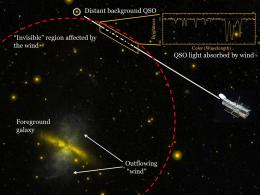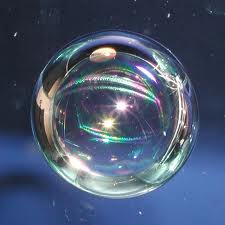It looks like you're using an Ad Blocker.
Please white-list or disable AboveTopSecret.com in your ad-blocking tool.
Thank you.
Some features of ATS will be disabled while you continue to use an ad-blocker.
4
share:
this is very interesting cutting edge research..

link to source
the gas envelope from a galaxy under study is giving insights into the "halo" type effect detected around most galaxies.
these are space bubble lenses at the galaxy scale.
and we are now exploring what the composition temperate and density of the bubble boundaries, allowing for a much more precise understanding of the compositional differences encountered at the boundry interface, this has implications on more precice mass light distrabution diagrams and of course the optical implications.
we can now say that our solar system is a bubble lens in a larger "galaxy bubble lens" with another bubble around that, and wind or gas outflowing from the center of a galaxy has an effect on the bubble interface.
missing mass
dark matter halo
gravitational lensing
this is a very important discovery
this is getting very exciting..
xploder

But Hubble's sensitive new Cosmic Origins Spectrograph (COS), the only one of its kind, has dramatically improved the quality of information regarding the gaseous envelope of galaxies, Tripp says. This huge gain in precision is one of the enormous accomplishments of the COS mission. "Even 10 years ago, most of the mass of a galaxy was invisible to us and such detailed investigations were impossible." the UMass Amherst astronomer points out. "With COS, in a sense we now have the ability to see the rest of the iceberg, not just the tip. This is a very exciting time to be an astronomer."
link to source
the gas envelope from a galaxy under study is giving insights into the "halo" type effect detected around most galaxies.
these are space bubble lenses at the galaxy scale.
and we are now exploring what the composition temperate and density of the bubble boundaries, allowing for a much more precise understanding of the compositional differences encountered at the boundry interface, this has implications on more precice mass light distrabution diagrams and of course the optical implications.
we can now say that our solar system is a bubble lens in a larger "galaxy bubble lens" with another bubble around that, and wind or gas outflowing from the center of a galaxy has an effect on the bubble interface.
With the new spectrograph we can see galaxy halos out to at least 150,000 parsecs," says Tripp. One kiloparsec is about 19 trillion miles. "Where once we saw only the framework we are now getting a more complete picture, including the composition and movement of gases in the envelope, varying temperatures in different locations and the chemical structure, all in incredible detail," Tripp adds.
In particular, data on the chemical composition and temperature in the gas clouds allow the astronomers to calculate a galaxy's halo mass and how the gaseous envelope regulates the galaxy's evolution.
Galaxies are the birthplaces of stars, each with a dense, visible central core and a huge envelope, or halo, around it containing extremely low-density gases. Until now, most of the mass in the envelope, as much as 90 percent of all mass in a galaxy, was undetectable by any instrument on Earth.
missing mass
dark matter halo
gravitational lensing
this is a very important discovery
this is getting very exciting..
xploder
edit on 17-11-2011 by XPLodER because: add pic
edit on 17-11-2011 by XPLodER because: (no reason given)
Thanks for the catch on this. My imagination has been firing ever since first hearing it confirmed by the Voyager probes that we're actually inside a
giant bubble with our Solar System. I can't help but wonder what new truths and facts we'll discover as we get probes and sensors on the other side
of that bubble interface and into interstellar space.
For instance, I wonder if we'll find distortion from the bubble has worked like the side mirror of a car. "Objects may be closer than they appear". Wouldn't it just be the news of a lifetime to learn that far from being so distant generational ships would be required, our neighboring stars are actually within reasonable distance in a single life time's trip? Perhaps we find some even closer. So many unknowns...but I'm happy to be alive during this time of history for THIS aspect, if nothing else.
For instance, I wonder if we'll find distortion from the bubble has worked like the side mirror of a car. "Objects may be closer than they appear". Wouldn't it just be the news of a lifetime to learn that far from being so distant generational ships would be required, our neighboring stars are actually within reasonable distance in a single life time's trip? Perhaps we find some even closer. So many unknowns...but I'm happy to be alive during this time of history for THIS aspect, if nothing else.
reply to post by Wrabbit2000

what gets interesting is that stars are lenses inside galaxies that are lenses that are in galaxy bubbles that are lenses.
it really can make things look smaller and further away
the universe is full of bubble shapped lenses
ats thread here
i have been working on just such a concept
its an exciting time to be interested in science
xploder

what gets interesting is that stars are lenses inside galaxies that are lenses that are in galaxy bubbles that are lenses.
it really can make things look smaller and further away
the universe is full of bubble shapped lenses
ats thread here
i have been working on just such a concept
its an exciting time to be interested in science
xploder
reply to post by XPLodER
Well since you've put a little time in it and have more than a passing interest, I wonder what you're take would be on an idea I'd thought of, and it works with your thread here. Since we are rather ..challenged.. on effective means of propulsion to get out and see these things, why not steal a ride? Why wouldn't it work to fire a tether or similar concept into passing asteroids/comets to literally hitch a ride with sensor packages?
Within a few years, we'd have sensors flying in all directions, all over the solar system and out into the larger galaxy. Wouldn't that help in getting past these bubbles and seeing what exists in deep space, without the time required to build the technology and ships to get there in person?
Oh well... Don't mean to sidetrack.. Like I said, since first hearing about the bubble as a real tangible thing, my imagination has been busy when thinking about what may be out 'there'.
Well since you've put a little time in it and have more than a passing interest, I wonder what you're take would be on an idea I'd thought of, and it works with your thread here. Since we are rather ..challenged.. on effective means of propulsion to get out and see these things, why not steal a ride? Why wouldn't it work to fire a tether or similar concept into passing asteroids/comets to literally hitch a ride with sensor packages?
Within a few years, we'd have sensors flying in all directions, all over the solar system and out into the larger galaxy. Wouldn't that help in getting past these bubbles and seeing what exists in deep space, without the time required to build the technology and ships to get there in person?
Oh well... Don't mean to sidetrack.. Like I said, since first hearing about the bubble as a real tangible thing, my imagination has been busy when thinking about what may be out 'there'.
new topics
-
2024 Pigeon Forge Rod Run - On the Strip (Video made for you)
Automotive Discussion: 24 minutes ago -
Gaza Terrorists Attack US Humanitarian Pier During Construction
Middle East Issues: 50 minutes ago -
The functionality of boldening and italics is clunky and no post char limit warning?
ATS Freshman's Forum: 1 hours ago -
Meadows, Giuliani Among 11 Indicted in Arizona in Latest 2020 Election Subversion Case
Mainstream News: 2 hours ago -
Massachusetts Drag Queen Leads Young Kids in Free Palestine Chant
Social Issues and Civil Unrest: 2 hours ago -
Weinstein's conviction overturned
Mainstream News: 4 hours ago -
Supreme Court Oral Arguments 4.25.2024 - Are PRESIDENTS IMMUNE From Later Being Prosecuted.
Above Politics: 5 hours ago -
Krystalnacht on today's most elite Universities?
Social Issues and Civil Unrest: 5 hours ago -
Chris Christie Wishes Death Upon Trump and Ramaswamy
Politicians & People: 6 hours ago -
University of Texas Instantly Shuts Down Anti Israel Protests
Education and Media: 8 hours ago
top topics
-
Krystalnacht on today's most elite Universities?
Social Issues and Civil Unrest: 5 hours ago, 8 flags -
Weinstein's conviction overturned
Mainstream News: 4 hours ago, 6 flags -
University of Texas Instantly Shuts Down Anti Israel Protests
Education and Media: 8 hours ago, 5 flags -
Supreme Court Oral Arguments 4.25.2024 - Are PRESIDENTS IMMUNE From Later Being Prosecuted.
Above Politics: 5 hours ago, 5 flags -
Meadows, Giuliani Among 11 Indicted in Arizona in Latest 2020 Election Subversion Case
Mainstream News: 2 hours ago, 4 flags -
Massachusetts Drag Queen Leads Young Kids in Free Palestine Chant
Social Issues and Civil Unrest: 2 hours ago, 3 flags -
Any one suspicious of fever promotions events, major investor Goldman Sachs card only.
The Gray Area: 10 hours ago, 2 flags -
Chris Christie Wishes Death Upon Trump and Ramaswamy
Politicians & People: 6 hours ago, 2 flags -
Gaza Terrorists Attack US Humanitarian Pier During Construction
Middle East Issues: 50 minutes ago, 1 flags -
God's Righteousness is Greater than Our Wrath
Religion, Faith, And Theology: 14 hours ago, 1 flags
4
